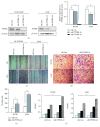Downregulation of PTPRK Promotes Cell Proliferation and Metastasis of NSCLC by Enhancing STAT3 Activation
- PMID: 30838170
- PMCID: PMC6374804
- DOI: 10.1155/2019/4265040
Downregulation of PTPRK Promotes Cell Proliferation and Metastasis of NSCLC by Enhancing STAT3 Activation
Abstract
Objective: The receptor-type tyrosine-protein phosphatase κ (PTPRK) is a candidate tumor suppressor involved in the tumorigenesis of various organs. However, its expression and biological roles in non-small-cell lung cancer (NSCLC) have not yet been investigated.
Methods: PTPRK expression in NSCLC tissues and cell lines was examined using real-time PCR and western blotting. In addition, the effects of PTPRK on cell migration, invasion, and proliferation were evaluated in vitro. Furthermore, we explored whether the downregulation of PTPRK led to STAT3 activation in NSCLC cell lines by western blotting. The expression of phospho-STAT3Tyr705 in primary human NSCLC tissues was evaluated by immunohistochemistry.
Results: The results showed that PTPRK expression was frequently reduced in NSCLC tissues with lymph node metastasis and cell lines. The inhibition of PTPRK expression resulted in increased proliferation, invasion, and migration of NSCLC cells in vitro. Additionally, after silencing of PTPRK, phospho-STAT3Tyr705 was significantly increased in NSCLC cells. Moreover, the phospho-STAT3Tyr705 levels of NSCLC tissues were positively correlated with lymph node metastasis and significantly inversely correlated with the expression of PTPRK (p < 0.05).
Conclusions: These results suggested that PTPRK functions as a novel tumor suppressor in NSCLC, and its suppressive ability may be involved in STAT3 activation.
Figures



References
MeSH terms
Substances
LinkOut - more resources
Full Text Sources
Miscellaneous

